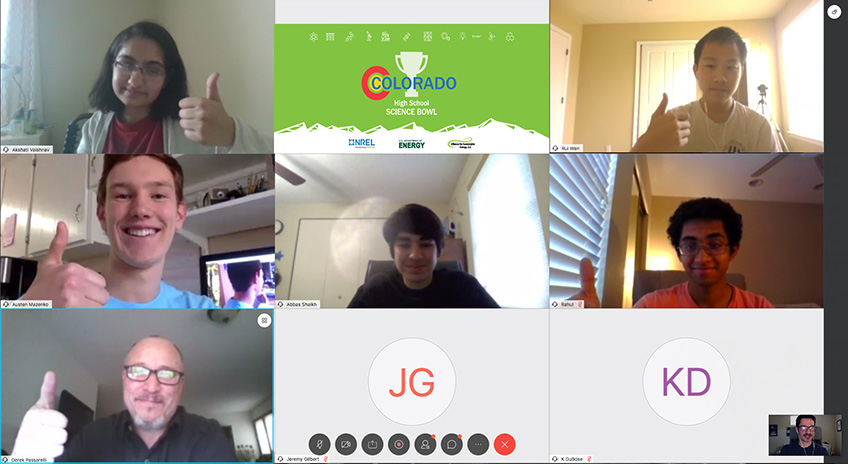Virtual Science Bowl Offers Practical Lessons in Learning and Creativity

The Cherry Creek High School team, joined by U.S. Department of Energy Golden Field Office Director Derek Passarelli (bottom left), gives the thumbs up after winning the 30th Colorado High School Science Bowl held virtually on Wednesday, May 6.
As Derek Passarelli, U.S. Department of Energy (DOE) Golden Field Office director, said at the 30th Colorado High School Science Bowl winner’s ceremony, all the students learned a valuable lesson in science. And not just from the difficult competition questions.
“In science, it may not go how you want it to go, but you have to be a bit creative to move forward,” Passarelli advised.
The National Renewable Energy Laboratory (NREL) Education Programs team put their creativity to the test in order to continue furthering the laboratory’s efforts to advance science, technology, engineering, and math (STEM) education in our community by hosting the regional science bowl online for the first time in the event’s history. The organizing team, along with 18 NREL and community volunteers, smoothly pivoted to a new format and technology. Previously training on the competition’s buzzer systems and timekeeping practices, volunteers quickly became technical specialists to address audio issues and connectivity complications for students.
“My goal was to keep things as simple as possible and provide a fair and valuable way for our students to compete,” said Tom Mason, NREL’s STEM education outreach coordinator. “Thanks to the many volunteers who contributed their time and energy, we were able to achieve that goal and advance a team to the national tournament. I’m extremely grateful to the team that pulled together to put on a successful event for these very deserving students.”
Thanks to their creativity, 15 teams from 11 Colorado high schools were able to compete in the regional science bowl. For the virtual competition, students were asked two rounds of 25 questions, with the top four teams advancing to the final round. The four teams, Denver’s Cherry Creek High School, Boulder’s Fairview High School, Fort Collins High School, and Poudre High School, also from Fort Collins, competed by answering another 50 questions.
The 11 schools that competed in the 30th Colorado High School Science Bowl were:
- Arvada West High School
- Cherry Creek High School (Denver)
- Colorado Early College of Aurora
- Fairview High School (Boulder)
- Fort Collins High School
- Fort Morgan High School
- Gilpin County High School
- Peak to Peak Charter School (Lafayette)
- Poudre High School (Fort Collins)
- Rock Canyon High School (Highlands Ranch)
- Rocky Mountain High School (Fort Collins)
In the final round, Cherry Creek unseated three-time defending champion Fort Collins. The Cherry Creek team, coached by Jeremy Gilbert, includes Austen Mazenko, Akshati Vaishnav, Rui Wen, Rahul Thomas, and Abbas Shaikh. Fairview and Poudre rounded out the competition winning third and fourth places, respectively.
The questions covered a wide range of STEM topics including biology, chemistry, mathematics, physics, earth and space sciences, and energy, including questions about the DOE’s 17 National Laboratories.
The Cherry Creek team now moves forward to the preliminary rounds of the DOE National Science Bowl—also being held virtually—later this month. Winners of these rounds will advance to the championship on June 6. As teams advance at the national competition, they are eligible to earn funding to support extracurricular STEM activities at their schools.
Going Virtual: To Be or Not To Be
After canceling the in-person event, Mason had the unenviable task of deciding whether to continue the competition in an untested online format or forgo the event entirely. According to Mason, the decision to continue was carefully considered and influenced by a student from Fairview High School who reached out with a suggestion on how to move forward. The student’s earnest dedication spurred the NREL team to find a way to make the event happen.
The same dedication was demonstrated by all the students who participated, as was a deep appreciation for the opportunity to compete. In multiple virtual competition rooms, “thank-yous” and gratitude flowed freely from coaches and students for giving them the opportunity to demonstrate the knowledge and skills that they gained in the course of their hard work preparing for the competition.
The virtual tournament utilized a video conferencing tool, and the organizers worked with students and coaches to create a comprehensive video monitoring setup. In addition to a webcam on a computer, students had to use a camera, most often on a cellphone, to share video of their work areas to ensure a fair competition. This setup encouraged creativity, with some students having their siblings or parents hold this second camera.
Competitors of Today and Scientists of Tomorrow
The Colorado High School Science Bowl, launched in 1991, encourages student involvement in STEM subjects through a fun and highly competitive contest. The event, sponsored and stewarded by the DOE since its inception, provides an opportunity for students to develop their STEM skills in a non-classroom environment.
The students competing in science bowl today may become the scientists and engineers of tomorrow who will lead the next generation of innovation toward our mission of advancing an energy future that is sustainable, reliable, resilient, and affordable.
“If you have any fears about the future, there is a lot of hope to be found in these motivated and brilliant minds, guided by dedicated teachers,” Passarelli said. “The students who participated in this competition were amazing.”
Last Updated May 28, 2025
